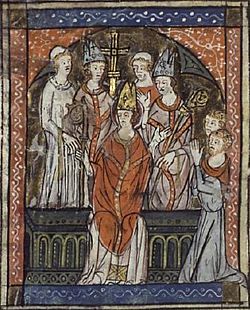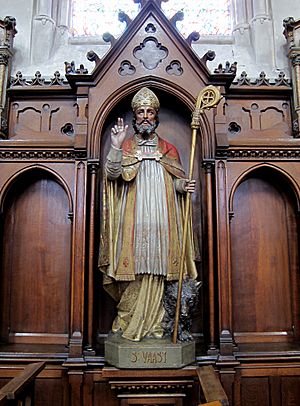Vedast facts for kids
Quick facts for kids SaintVedast |
|
|---|---|

The ordination of Saint Vedast
|
|
| Born | c. 453 France |
| Died | 540 |
| Venerated in | Eastern Orthodox Church Roman Catholic Church |
| Canonized | Pre-Congregation |
| Feast | February 6 |
| Attributes | a child at his feet; a bear; bishop with a wolf carrying a goose in its mouth |
| Patronage | invoked on behalf of children who walk with difficulty for diseases of the eyes diocese of Arras, Boulogne and Saint-Omer, France France |
Saint Vedast (also known as Saint Vaast or Saint Gaston) was an important early bishop. He lived a long time ago, around the year 500. He helped teach the Christian faith to King Clovis, a powerful ruler of the Franks. The Franks were a group of people who lived in what is now France.
Contents
Vedast's Early Life and Calling
Vedast was likely born in a village called Villae in Périgord, France. When he was a young man, he moved to a town called Toul. The bishop there noticed how good and kind Vedast was. Because of this, the bishop made Vedast a priest.
Meeting King Clovis
King Clovis was returning from a big victory in a battle. He was thinking about becoming a Christian, like his wife, Queen Clotilde. On his way to the city of Rheims, he stopped in Toul. He asked for a priest to help him learn more about the Christian faith. Vedast agreed to go with the king and teach him.
It is believed that in 499, Vedast became the first bishop of Arras in France. Later, around 510, he also became responsible for the church in Cambrai. However, some historians think Vedast was more of a traveling bishop. This means he helped churches in different places without having one specific main church.
Amazing Stories About Saint Vedast
People believed that Vedast could perform amazing healings. These stories are part of Christian tradition.
The Blind Beggar
One story says that Vedast and King Clovis were traveling to Rheims. They came across a blind beggar near a river called the Aisne. The man asked Vedast for help. Vedast prayed and blessed the beggar. Right away, the man could see again! This miracle made King Clovis respect Vedast even more. Vedast became one of the King's trusted advisors.
The Bear in the City
Another story tells how Vedast helped a city. He is said to have driven a wild bear out of the city. This story shows how people believed Vedast had power over nature.
The Overflowing Wine
There is also a story about Vedast and some wine. One day, Vedast had spent a long time teaching a nobleman. The nobleman wanted to offer Vedast a glass of wine. But when they checked, the wine barrel was empty! Vedast told a servant to bring whatever they found in the barrel. The servant then found the barrel full of excellent wine.
Death and How He Is Remembered
Saint Vedast died around the year 540 in Arras. People in the area said they saw a bright cloud rise from his house that night. They believed it was Vedast's soul going to heaven. Vedast was buried in the old cathedral in Arras. Later, his bones were moved to a new church built in his honor. This church is called the Abbey of St. Vaast.
Vedast was honored in Belgium and England. In England, he was sometimes called Saint Foster. Churches were named after him, like St. Vedast Church, Vlamertinge. His story spread because monks from Arras came to England in the 1100s. Three old churches in England are named after him: St Vedast Foster Lane in London, and churches in Norwich and Tathwell.
His special day, called a feast day, is on February 6.
Patron Saint
Saint Vedast is known as a patron saint for people with eye problems. He is also invoked to help children who have trouble walking.
See also
 In Spanish: Gastón de Arrás para niños
In Spanish: Gastón de Arrás para niños



